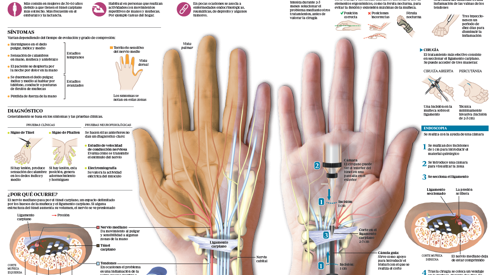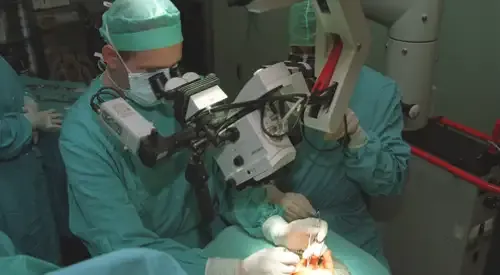Carpal Tunnel Syndrome
"Virtually all patients experience satisfactory improvement with surgical treatment, and relapses are unlikely".
DR. ALEJANDRO ALMOGUERA
SPECIALIST. ORTHOPEDIC SURGERY AND TRAUMATOLOGY DEPARTMENT

What is carpal tunnel?
The carpal tunnel is a channel or corridor on the anterior or flexor side of the wrist, located between the wrist bones and the carpal ring ligament, through which the flexor tendons of the fingers and the median nerve pass.
The syndrome of the tunnel carpal is a disease that produces damage of the medium nerve. If there is, by any cause, an increase of the pressure within that carpal tunnel an injury in that nerve can take place.
The slight cases can evolve favorably with treatment by immobilization of the wrist or with the injection of corticoids. In more advanced cases, the solution is always surgical, releasing the nerve trapped in the carpal tunnel.
Virtually all patients experience a very satisfactory improvement with surgical treatment.

What are the symptoms of carpal tunnel?
At first, most patients complain of pain in the wrist and forearm region, associating a corking sensation, cramps and tingling in the thumb, index, middle and part of the ring finger. These symptoms are typically nocturnal and/or postural.
Later, if not treated, weakness and atrophy of some of the muscles of the hand will appear (especially in the tenar eminence or padding under the thumb), as well as clumsiness when manipulating objects.

Diagnosis and treatment of carpal tunnel syndrome (only in spanish)
The most common symptoms are:
- Pain in the wrist and forearm.
- Cramps and tingling in fingers.
Do you have any of these symptoms?
You may have carpal tunnel syndrome
What are the causes of carpal tunnel?
There are so many tendons that cross this channel that the median nerve has a very fair space in its central area.
If, for any reason, this space decreases even more, then the pressure inside it increases, resulting in compression of the median nerve. There are multiple causes that can cause this compression of the nerve, although on many occasions no associated disease is identified, there are also a few family cases.
It can be associated with endocrine diseases (hypothyroidism or acromegaly), rheumatic diseases (rheumatoid arthritis), deposition diseases (amyloidosis, mucopolysaccharidosis), tumors (multiple myeloma, hemangioma, lipoma), steroid or estrogenic treatment and pregnancy or breastfeeding.
It is quite common that it is related to occupations or activities involving repetitive manual maneuvers (repeated hand and wrist movements, repetitive forced positions of the wrist) or local trauma (regular and continuous use of vibrating hand tools).
What is your prognosis?
This is an intervention that usually has no complications. After the surgery the pain disappears in days, and the rest of the symptoms improve in a short time, depending on the severity of the injury.
The results that are obtained vary in the different series, being in the most extensive and with greater number of patients the following:
- Improvement of pain and paresthesia: open (98%), endoscopic (99%).
- Satisfaction with the technique: open (84%), endoscopic (89%).
- Earlier return to work with the endoscopic.
- Overall rate of complications of endoscopy: 1.8% out of about 17,000 procedures (varies with different techniques).
- Nerve injuries (palmar skin branch, tenar motor branch, common digital nerves, median nerve, ulnar nerve) of endoscopy: 0.8%.
How is carpal tunnel diagnosed?

After clinical suspicion, an exploration of the sensitivity and strength of the hand should be performed, as well as maneuvers that trigger the symptoms.
To confirm the diagnosis and assess the degree of medium nerve involvement (mild, moderate or severe) a neurophysiological study is usually requested, consisting of an electromyography (EMG) and a nerve conduction study (NCS).
Carpal tunnel syndrome can be associated with endocrine and rheumatic diseases, estrogen treatment, pregnancy, some tumors, etc.; that is why if there is suspicion of these diseases, the diagnosis can be complemented with analytical or imaging tests that help find the cause.
How is carpal tunnel treated?
In those cases in which an associated disease is identified, an adequate treatment must be established.
Conservative treatment
It is indicated in mild cases, with lack of atrophy of the tenar eminence, or pregnancy. These patients may respond to anti-inflammatory drugs (steroids or non-steroids) and hand rest with nighttime dorsal splint in extension that covers hand and forearm.
In chronic cases, occupational rehabilitation is also useful. If symptoms persist, local steroid infiltration can be performed.
Endoscopic carpal tunnel surgery can be performed on an outpatient basis or with a stay of several hours, since it is of short duration and is performed under local or regional anesthesia.
A small incision is made in the wrist, the tissues are dissected until the median nerve is identified, and the median nerve is released completely along the carpal tunnel after a cross section of the carpal ring ligament is made.
After the surgery, a bandage is placed on the wrist and the hand is raised with the help of a sling, to prevent bleeding and inflammation. It is important to move your fingers a lot and not to bend your wrist.
This is an intervention that usually has no complications. After the surgery the pain disappears in days, and the rest of the symptoms improve in brief term, depending on the gravity of the injury.
Where do we treat it?
IN NAVARRA AND MADRID
The Department of Orthopedic Surgery and Traumatology
of the Clínica Universidad de Navarra
The Department of Orthopedic Surgery and Traumatology covers the full spectrum of congenital or acquired conditions of the musculoskeletal system including trauma and its aftermath.
Since 1986, the Clinica Universidad de Navarra has had an excellent bank of osteotendinous tissue for bone grafting and offers the best therapeutic alternatives.
Organized in care units
- Hip and knee.
- Spine.
- Upper extremity.
- Pediatric orthopedics.
- Ankle and foot.
- Musculoskeletal tumors.

Why at the Clinica?
- Experts in arthroscopic surgery.
- Highly qualified professionals who perform pioneering techniques to solve traumatological injuries.
- One of the centers with the most experience in bone tumors.




















